Complete Solutions to Section A -Problem of chapter ORGANIC CHEMISTRY SOME BASIC PRINCIPLES AND TECHNIQUES of Class 11 book with complete answers and questions
| Class 11 | CHEMISTRY |
| Chapter | ORGANIC CHEMISTRY SOME BASIC PRINCIPLES AND TECHNIQUES |
| KUMAR PRAKASHAN | Section A -Problem |
| Number Of Questions | 100 |
| Academic Year | 2023-24 |
How many `sigma and pi` bonds are present in each of the following molecules?
(a) `HC -= C CH= CHCH_(3)`
(b) `CH_(2) = C = CHCH_(3)`
View SolutionWhat is the type of hybridisation of each carbon in the following compounds?
(a) `CH_(3)Cl` (b) `(CH_(3))_(2)CO` (c ) `CH_(3)CN` (d) `HCONH_(2)` (e ) `CH_(3)CH = CHCN`
View SolutionWrite the state of hybridisation of carbon in the following compounds and shapes of each of the molecules
(a) `H_(2)C = O` (b) `CH_(3)F` (c ) `HC -= N`
View SolutionWhat are hybridisation states of each carbon atom in the following compounds?
(i) `CH_(2) = C = O` (ii) `CH_(3)CH = CH_(2)` (iii) `(CH_(3))_(2)CO` (iv) `CH_(2) = CHCN` (v) `C_(6)H_(6)`
View SolutionIndicate the `sigma and pi` bonds in the following molecules:
(i) `C_(6)H_(6)` (ii) `C_(6)H_(12)` (iii) `CH_(2)Cl_(2)` (iv) `CH_(2) = C = CH_(2)` (v) `CH_(3) NO_(2)` (vi) `HCONH CH_(3)`
View SolutionHow many `sigma and pi` bonds in the following examples?
(a) `CH_(3)C -=N ` (b) `CH_(2) = C = CH_(2)` (c ) `C_(2)H_(6)` (d) `CH_(2) = CH - CH_(2) - C -= CH` (e ) `CH_(3)COOH`
View SolutionWhat is the hybridisation of carbon in problem
View SolutionWhich hybridisation of carbon is same in the following? Give type of hybridisation
(a) `CH_(2) = C = CH_(2)` (b) `CH_(2) = CH - CH = CH - CH = CH_(2)` (c ) `HC -= C - C -= C - C -= CH`
(d) `CH_(2) = CH - CH = CH_(2)` (e ) `CH_(3)C -= C- CH_(3)` (f) `C_(6) H_(6)` (g) `C_(6)H_(12)` (cyclic comp) (h) `CH_(3) - CH = CH - CH= CH_(3)`
View SolutionIn which of the following has only one `pi` bond?
(a) `CH_(3)COCH_(3)` (b) `CH_(3)CHO` (c ) `CH_(3)CONH_(2)` (d) `C_(2)H_(2)` (e ) `C_(2)H_(4)` (f) `CH_(3)CH= CH_(2)` (g ) `CH_(3) - CH= CHCN` (h) `CH_(3)COOH` (i) `C_(6)H_(5) COOH`
View SolutionWrite 3-methyl octane in various formula
View SolutionWrite 2-bromobutane in various form
View SolutionWrite condensed and line structure of cyclo-propane, cyclopentane and chlorocyclohexane.
View SolutionExpand each of the following condensed formulas into their complete structural formulas.
(a) `CH_(3)CH_(2)COCH_(2)CH_(3)`
(b) `CH_(3)CH = CH(CH_(2))_(3) CH_(3)`
View SolutionFor each of the following compounds, write a condensed formula and also their bond-line formula.
(a) `HO CH_(2) CH_(2) CH_(2) CH (CH_(3)) CH (CH_(3)) CH_(3)`
(b) `N -= C -overset(overset(OH)(|))(CH)- C -=N`
View SolutionExpand each of the following bond0line formulas to show all the atoms including carbon and ydrogen
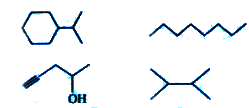
View SolutionGive condensed and bond line structural formulas and identify the functional group (s) present, If any, for:
(a) 2, 2, 4-Trimethylpentane
(b) 2-Hydroxy-1, 2, 3-propanetricarboxylic acid
(c ) Hexanedial
View SolutionWrite bond line formulas for: Isopropyl alcohol, 2, 3-Dimethylbutanal, Heptan-4-one
View SolutionGive line and condensed formula of following
(i) `CH_(3)CH_(2) CH_(2) CH_(2) CH_(2) CH_(2) CHBr CH_(2) CHO`
(ii) `CH_(3) - underset(underset(CH_(3))(|))(C H) - CH_(2)OH`
(iii) `NH_(2) - CH_(2) CH_(2) CH_(2) CH_(2) CH_(2) CH_(2) COOH`
(iv) `CH_(3) CH_(2) CH_(2)OH`
View SolutionWrite complete structural formula of following condensed formula with C and H
(i) `HO CH_(2) CH_(2) NH_(2)` (ii) `CH_(3) (CH_(2))_(3) OH`
(iii) `CHO (CH_(2))_(3) CHO` (iv) `CH_(3) COCH_(2) COOH`
View SolutionWrite complete structural formula containing C and H of following line formula
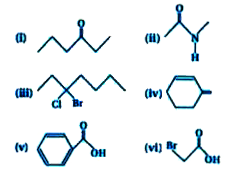
View SolutionWrite line formula and dash formula of following condensed formula.
(i) `CH_(2)OH CHOH CH_(2)OH`
(ii) `CH_(3) CH_(2) CHOH CH_(2) CH_(2)OH`
(iii) `CH_(3)CO CH_(2) CH_(2) CH (CH_(3))_(2)`
(iv) `H_(2)NCH_(2) COOH`
View SolutionWrite complete structure including C, H,… atom of the following

View SolutionGive (i) structural formula (ii) dash formula and IUPAC name of `(CH_(3))_(3) CH_(2)CH (CH_(3))_(2)`
View SolutionWrite dash formula and complete structural formula of 2, 4-dimethylpentane and then decide IUPAC name
View SolutionStructures and IUPAC names of some hydrocarbons are given below. Explain why the names given in the parentheses are incorrect.
(a) `underset("2, 5,6-Trimethyloctane (and not 3,4,7-Trimethyloctane)")(CH_(3) - underset(underset(CH_(3))(|))(CH)- CH_(2) - CH_(2) - underset(underset(CH_(3))(|))(CH)-underset(underset(CH_(3))(|))(CH)-CH_(2) - CH_(3))`
(b) `underset("3-Ethyl-5-methylheptane (and not 5-Ethyl-3-methylheptane)")(CH_(3) - CH_(2) - underset(underset(CH_(2)CH_(3))(|))(CH)- CH_(2) - underset(underset(CH_(3))(|))(CH)- CH_(2) - CH_(3))`
View Solution`CH_(3) - CH_(2) - CH - overset(overset(CH(CH_(3))_(2))(|))(CH) - underset(underset(H_(3)C- CH- CH_(2) - CH_(3))(|))(CH) - CH_(2) - CH_(2) - CH_(2) - CH_(2) - CH_(3)`
Which IUPAC name is write from these name 5-sec-Butyl-4-isopropyldecane and 4-isopropyl-5-(1-methylpropyl) Decane?
View SolutionIn above problem -26, why the IUPAC name 4-isopropyl-5-secondary butyldecane is wrong?
View Solution`H_(3)C- underset(underset(CH_(3))(|))(CH) - CH_(2) - underset(underset(CH_(3))(|))(CH) - underset(underset(CH_(3))(|))(CH) - CH_(3)`
(i) 2, 3, 5- Trimethyl hexane and
(ii) 2, 4, 5-Trimethyl hexane which name is correct ? Why?
View SolutionGive the correct order of substitute group in the following
(a) `H_(3)C - underset(underset(CH_(3))(|))overset(overset(CH_(3))(|))(C )- CH_(2) - overset(overset(CH_(3))(|))(CH) - CH_(3)`
(b) `H_(3)C - underset(underset(CH_(3))(|))overset(overset(CH_(3))(|))(C )- underset(underset(CH_(3))(|))(CH) - overset(overset(CH_(3))(|))(CH) - CH_(3)`
(c ) `CH_(3)CH_(2)CH (CH_(3))CH (CH_(3))(CH_(2))(4) CH (CH_(3))_(2)`
(d) `CH_(3)CH_(2)CH (CH_(3))CH (C_(2)H_(5)) CH_(2)CH_(2)CH_(3)`
(e ) `(CH_(3))_(3)C CH (C_(2)H_(5)) CH_(2)CH_(3)`
(f ) `(CH_(3))_(2) CH (CH_(2))_(4) CH (CH_(3)) CH C(C_(2)H_(5))_(2)`
View SolutionWrite IUPAC name of following:
(i) `(CH_(3))_(4)C` (b) `[(CH_(3))_(2) CH] CH_(2)` (c ) `(CH_(3))_(2) CH CH_(2)C (CH_(3))_(3)` (d) `(C_(2)H_(5))_(4)C` (e ) `(CH_(3))_(2) CHCH_(2) CH(CH_(3)) CH_(2)CH(CH_(3))_(2)` (f) `(C_(2)H_(5))_(2) C(CH_(3)) CH (CH_(3))_(2)` (g) `(CH_(3)CH_(2))_(2) CH- C(CH_(3))_(2)- CH_(2)CH_(2)CH_(3)` (h) `(CH_(3))_(3)C C(CH_(3))(C_(2)H_(5)) CH_(2)CH_(2)CH_(3)`
View SolutionWrite IUPAC name and write condensed structure, dash structure line formula of problem
View SolutionWrite the IUPAC names of the compounds i-iv from their given structures:
(i) `overset(1)(CH_(3))- overset(2)(CH_(2))- underset(underset(OH)(|))overset(3)(CH)- overset(4)(CH_(2))- overset(5)(CH_(2)) - underset(underset(CH_(3))(|))overset(6)(CH)- overset(7)CH_(2) - overset(8)(CH_(3))`
(ii) `overset(6)(CH_(3)) - overset(5)(CH_(2))- underset(underset(O)(||))overset(4)(C )- overset(3)(CH_(2)) - underset(underset(O)(||))overset(2)(C )- overset(1)(CH_(3))`
(iii) `overset(6)(CH_(3)) - underset(underset(O)(||))overset(5)(C )- overset(4)(CH_(2)) - overset(3)(CH_(2)) - overset(2)(CH_(2))- overset(1)(C )OOH`
(iv) `overset(6)(CH) -= overset(5)(C )- overset(4)(CH) = overset(3)(CH) - overset(2)(CH) = overset(1)(CH_(2))`
View SolutionDerivce the sturcture of
(i) 2-Chlorohexane (ii) Pent -4-en-2-ol (iii) 3-Nitrocyclohexene (iv) Cyclohex-2-en-1-ol (v) 6-Hydroxyheptanal
View SolutionWhich of the following represents the correct IUPAC name for the compounds concerned?
(a) 2, 2-Dimethylpentane OR 2-Dimethylpentane
(b) 2, 4, 7-Trimethyloctane OR 2, 5,7-Trimethyloctane
(c ) 2-Chloro-4-methylpentane OR 4-Chloro-2-methylpentane
(d) But 3-yn-1-ol OR But -4-ol-1-yne
View SolutionGive IUPAC name of following
(i) `CH_(3)COOCH_(3)` (ii) `CH_(3)COOCH_(2)CH_(3)` (iii) `CH_(3)CH_(2)COOCH_(3)` (iv) `HCOOCH_(3)`
View SolutionDerive IUPAC name of following:

View SolutionWrite the structural formula of:
(a) o-ethylanisole (b) p-nitroaniline (c ) 2, 3-dibromo-1-phenylpentane (d) 4-ethyl-1-fluoro-2-nitrobenzene
View SolutionGive the IUPAC names of the following compounds:
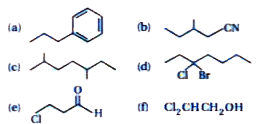
`Cl_(2)CHCH_(2)OH`
View SolutionDraw formulas for the first five members of each homologous series beginning with the following compounds.
(a) HCOOH (b) `CH_(3)COCH_(3)` (c ) `H- CH = CH_(2)`
View SolutionIdentify the functional groups in the following compounds:

View SolutionGive structure and name of one double bond containing cyclic compound
View SolutionWhich of the main functional group in the following ?
(a) `CH_(2)OH -CH_(2)-CHF-CH_(2)COOH` (b) `(CH_(3))_(2) CHCOCOOH` (c ) `CH_(3)CH_(2) underset(underset(NH_(2))(|))(C )HOH` (d) `CH_(3)COCH_(2)CH_(2)OH` (e ) `CH_(2)CH(NH_(2))COOH` (f) `CHOCH_(2)COCH_(2)CH_(3)`
View SolutionGive name of following
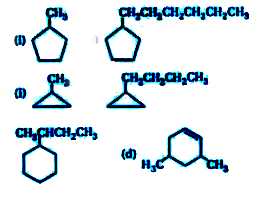
View SolutionWrite IUPAC name of following
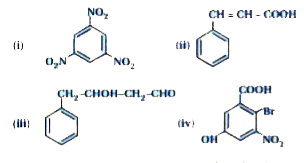
View SolutionGive structure of following
(i) Cyclohexane-1, 2-diol (ii) Vinylalcohol (iii) 2-bromo-4-methylaniline (iv) 3-hydroxy-1, 3-5-pentantrioicacid OR 3-hydroxy-1, 2, 3-propentricarboxylicacid
View SolutionUsing curved-arrow notation, show the formation of reactive intermediates when the following covalent bonds undergo heterolytic cleavage.
(a) `CH_(3) - SCH_(3)`, (b) `CH_(3) - CH`, (c ) `CH_(3) - Cu`
View SolutionGiving justification categories the following molecules/ions as nucleophile or electrophile: `HS^(-), BF_(3), C_(2)H_(5)O^(-), (CH_(3))_(3)N`,
`C overset(+)(1), CH_(3) overset(+)(C )= O, H_(2)N^(-), overset(+)(N) O_(2)`
View SolutionIdentify electrophilic centre in the following: `CH_(3)CH= O, CH_(3)CN, CH_(3)I`
View SolutionIdentify the reagents shown in boid in the following equations as nucleophiles or electrophiles:
(a) `CH_(3)COOH + HO^(-) rarr CH_(3)COO^(-) + H_(2)O` (b) `CH_(3)COCH_(3) + bar(C )N rarr (CH_(3))_(2)C(CN)(OH)`
(c ) `C_(6)H_(5) + CH_(3) overset(+)(C )O rarr C_(6)H_(5)COCH_(3)`
View SolutionClassify the following reactions in one of the reaction type studied in this unit.
(a) `CH_(3)CH_(2)Br + HS^(-) rarr CH_(3)CH_(2)SH + Br^(-)`
(b) `(CH_(3))_(2) C = CH_(2) + HCl rarr (CH_(3))_(2) ClC - CH_(3)`
(c ) `CH_(3)CH_(2)Br + HO^(-) rarr CH_(2) = CH_(2) + H_(2)O + Br^(-)`
(d) `(CH_(3))_(3)C - CH_(2)OH + HBr rarr (CH_(3))_(2) CBrCH_(2)CH_(2)CH_(3) + H_(2)O`
View SolutionWhich bond is more polar in the following pairs of molecules
(a) `H_(3)C- H, H_(3)C- Br`
(b) `H_(3)C- NH_(2), H_(3)C-OH`
(c ) `H_(3)C- OH, H_(3)C- SH`
View SolutionIn which C-C bond of `CH_(3)CH_(2)CH_(2)Br`, the inductive effect is expected to be the least?
View SolutionWhich of the following have maximum strongly of attractive inductive effects?
(a) `CH_(3)CH_(3)Cl, CH_(3)CH_(2)Br, CH_(3)CH_(2)F, CH_(3)F`
(b) `CH_(3)COOH, CH_(2)ClCOOH, CHCl_(2)COOH`
(c ) `(CH_(3))_(3) C COOH, (CH_(3))_(2) CHCOOH, CH_(3)COOH`
View SolutionRepresent the inductive effect in: (a) `CH_(3)COOH`, (b) `C Cl_(3)COOH` and (c ) `CH_(3)COOH`
View SolutionWrite resonance structures of `CH_(3)COO^(-)` and show the movement of electrons by curved arrows
View SolutionWrite resonance structures of `CH_(2)= CH-CHO`. Indicate relative stability of the contributing structures
View SolutionExplain why the following two structures, I and II cannot be the major contributors to the real structure of `CH_(3)COOCH_(3)`.
`underset((I))(CH_(3) - underset(+)overset(overset(bar( : overset(..)O: ))(|))(C )- underset(..)overset(..)(O) - CH_(3)) harr underset((II))(CH_(3) - overset(overset(bar( : overset(..)O: ))(|))(C )= underset(..)overset(+)(O)- CH_(3))`
View SolutionWhich of the two : `O_(2)NCH_(2)CH_(2)O^(-) or CH_(3)CH_(2)O^(-)` is expected to be more stable and why?
View SolutionWhat is the relationship between the members of following pairs of structure ? Are they structural or geometrical isomers or resonance contributors?

(c ) `H- overset(overset(""^(+)OH)(||))(C )-OH " " H - overset(overset(OH)(|))(C^(+))- OH`s
View SolutionFor the following bond cleavages, use curved arrows to show the electron flow and classify each as homolysis or heterolysis. Identify reactive intermediate produced as free radical, carbocation and carbanion
(a) `CH_(3)O- OCH_(3) rarr CH_(3) overset(.)(O) + overset(.)(O)CH_(3)`
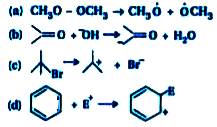
View SolutionDraw the resonance structures for the following compounds. Show the electron shift using curved-arrow notation.
(a) `C_(6)H_(5)OH` (b) `C_(6)H_(5)NO_(2)` (c ) `CH_(3)CH= CHCHO` (d) `C_(6)H_(5)-CHO` (e ) `C_(6)H_(5)- overset(+)(C )H_(2)` (f ) `CH_(3)CH= CH overset(+)(C )H_(2)`
View SolutionThe resonance effect of groups is electron removing (+R) or electron attracting (-R)?
View SolutionExplain the terms inductive and Electromeric effects. Which electron displacement effect explains the following correct orders of acidity of the carboxylic acids?
(a) `Cl_(3)C COOH gt Cl_(2)CHCOOH gt ClCH_(2)COOH` (b) `CH_(3)CH_(2)COOH gt (CH_(3))_(2)CHCOOH gt (CH_(3))_(3) C.COOH`
View SolutionExplain why `(underset(+)(C )H_(3))_(3) overset(+)(C )` is more stable than `CH_(3)CH_(2) and CH_(3)` is the least stable cation
View SolutionOn complete combustion, 0.246g of an organic compound gave 0.198g of carbon dioxide and 0.1014g of water, Determine the percentage composition of carbon and hydrogen in the compound.
View SolutionAn organic compound contains 69% carbon and 4.8% hydrogen, the remainder being oxygen. Calculate the masses of carbon dioxide and water produced when 0.20g of this substance is subjected to complete combustion
View SolutionIn Dumas' method for estimation of nitrogen, 0.3g of an organic compound gave 50mL of nitrogen collected at 300K temperature and 715 mm pressure. Calculate the percentage composition of nitrogen in the compound. (Aqueous tension at 300K = 15mm)
View SolutionDuring estimation of nitrogen present in an organic compound by Kjeldahl's method, the ammonia evolved from 0.5g of the compound in Kjeldahl's estimation of nitrogen, neutralized 10 mL of `1M H_(2)SO_(4)`. Find out the percentage of nitrogen in the compound
View SolutionA sample of 0.50g of an organic compound was treated according to Kjeldahl's method. The ammonia evolved was absorbed in 50ml of `0.5M H_(2)SO_(4)`. The residual acid required 60mL of 0.5M solution of NaOH for neutralisation. Find the percentage composition of nitrogen in the compound
View SolutionIn Carius method of estimation of halogen, 0.15 g of an organic compound gave 0.12g of AgBr. Find out the percentage of bromine in the compound (Ag = 108, Br= 80)
View Solution0.3780g of an organic chloro compound gave 0.5740g of silver chloride in Carius estimation. Calculate the percentage of chlorine present in the compound (Ag= 108, Cl= 35.5)
View SolutionIn sulphur estimation, 0.157 g of an organic compound gave 0.4813 g of barium sulphate. What is the percentage of sulphur in the compound ? (Ba = 136, S= 32, O= 16)
View SolutionIn carious method 0.12g AgBr obtained from 0.15g organic compound. Find out the percentage of AgBr in compound. (Ag= 108, Br =80)
View SolutionIn the estimation of sulphur by Carius method, 0.468g of an organic sulphur compound afforded 0.668g of barium sulphate. Find out the percentage of sulphur in the given compound.
(Ba= 137, S=32, O=16)
View Solution0.12g organic compound gave 0.22g `Mg_(2)P_(2)O_(7)`. What is the percentage of phosphorus in compound? (P= 31) (Molar mass of `Mg_(2)P_(2)O_(7)= 222g`)
View SolutionHow many `sigma and pi` bonds are present in each of the following molecules?
(a) `HC -= C CH= CHCH_(3)`
(b) `CH_(2) = C = CHCH_(3)`
View SolutionWhat is the type of hybridisation of each carbon in the following compounds?
(a) `CH_(3)Cl` (b) `(CH_(3))_(2)CO` (c ) `CH_(3)CN` (d) `HCONH_(2)` (e ) `CH_(3)CH = CHCN`
View SolutionWrite the state of hybridisation of carbon in the following compounds and shapes of each of the molecules
(a) `H_(2)C = O` (b) `CH_(3)F` (c ) `HC -= N`
View SolutionWhat are hybridisation states of each carbon atom in the following compounds?
(i) `CH_(2) = C = O` (ii) `CH_(3)CH = CH_(2)` (iii) `(CH_(3))_(2)CO` (iv) `CH_(2) = CHCN` (v) `C_(6)H_(6)`
View SolutionIndicate the `sigma and pi` bonds in the following molecules:
(i) `C_(6)H_(6)` (ii) `C_(6)H_(12)` (iii) `CH_(2)Cl_(2)` (iv) `CH_(2) = C = CH_(2)` (v) `CH_(3) NO_(2)` (vi) `HCONH CH_(3)`
View SolutionHow many `sigma and pi` bonds in the following examples?
(a) `CH_(3)C -=N ` (b) `CH_(2) = C = CH_(2)` (c ) `C_(2)H_(6)` (d) `CH_(2) = CH - CH_(2) - C -= CH` (e ) `CH_(3)COOH`
View SolutionWhat is the hybridisation of carbon in problem
View SolutionWhich hybridisation of carbon is same in the following? Give type of hybridisation
(a) `CH_(2) = C = CH_(2)` (b) `CH_(2) = CH - CH = CH - CH = CH_(2)` (c ) `HC -= C - C -= C - C -= CH`
(d) `CH_(2) = CH - CH = CH_(2)` (e ) `CH_(3)C -= C- CH_(3)` (f) `C_(6) H_(6)` (g) `C_(6)H_(12)` (cyclic comp) (h) `CH_(3) - CH = CH - CH= CH_(3)`
View SolutionIn which of the following has only one `pi` bond?
(a) `CH_(3)COCH_(3)` (b) `CH_(3)CHO` (c ) `CH_(3)CONH_(2)` (d) `C_(2)H_(2)` (e ) `C_(2)H_(4)` (f) `CH_(3)CH= CH_(2)` (g ) `CH_(3) - CH= CHCN` (h) `CH_(3)COOH` (i) `C_(6)H_(5) COOH`
View SolutionWrite 3-methyl octane in various formula
View SolutionWrite 2-bromobutane in various form
View SolutionWrite condensed and line structure of cyclo-propane, cyclopentane and chlorocyclohexane.
View SolutionExpand each of the following condensed formulas into their complete structural formulas.
(a) `CH_(3)CH_(2)COCH_(2)CH_(3)`
(b) `CH_(3)CH = CH(CH_(2))_(3) CH_(3)`
View SolutionFor each of the following compounds, write a condensed formula and also their bond-line formula.
(a) `HO CH_(2) CH_(2) CH_(2) CH (CH_(3)) CH (CH_(3)) CH_(3)`
(b) `N -= C -overset(overset(OH)(|))(CH)- C -=N`
View SolutionExpand each of the following bond0line formulas to show all the atoms including carbon and ydrogen

View SolutionGive condensed and bond line structural formulas and identify the functional group (s) present, If any, for:
(a) 2, 2, 4-Trimethylpentane
(b) 2-Hydroxy-1, 2, 3-propanetricarboxylic acid
(c ) Hexanedial
View SolutionWrite bond line formulas for: Isopropyl alcohol, 2, 3-Dimethylbutanal, Heptan-4-one
View SolutionGive line and condensed formula of following
(i) `CH_(3)CH_(2) CH_(2) CH_(2) CH_(2) CH_(2) CHBr CH_(2) CHO`
(ii) `CH_(3) - underset(underset(CH_(3))(|))(C H) - CH_(2)OH`
(iii) `NH_(2) - CH_(2) CH_(2) CH_(2) CH_(2) CH_(2) CH_(2) COOH`
(iv) `CH_(3) CH_(2) CH_(2)OH`
View SolutionWrite complete structural formula of following condensed formula with C and H
(i) `HO CH_(2) CH_(2) NH_(2)` (ii) `CH_(3) (CH_(2))_(3) OH`
(iii) `CHO (CH_(2))_(3) CHO` (iv) `CH_(3) COCH_(2) COOH`
View SolutionWrite complete structural formula containing C and H of following line formula

View SolutionWrite line formula and dash formula of following condensed formula.
(i) `CH_(2)OH CHOH CH_(2)OH`
(ii) `CH_(3) CH_(2) CHOH CH_(2) CH_(2)OH`
(iii) `CH_(3)CO CH_(2) CH_(2) CH (CH_(3))_(2)`
(iv) `H_(2)NCH_(2) COOH`
View SolutionWrite complete structure including C, H,… atom of the following

View SolutionGive (i) structural formula (ii) dash formula and IUPAC name of `(CH_(3))_(3) CH_(2)CH (CH_(3))_(2)`
View SolutionWrite dash formula and complete structural formula of 2, 4-dimethylpentane and then decide IUPAC name
View SolutionStructures and IUPAC names of some hydrocarbons are given below. Explain why the names given in the parentheses are incorrect.
(a) `underset("2, 5,6-Trimethyloctane (and not 3,4,7-Trimethyloctane)")(CH_(3) - underset(underset(CH_(3))(|))(CH)- CH_(2) - CH_(2) - underset(underset(CH_(3))(|))(CH)-underset(underset(CH_(3))(|))(CH)-CH_(2) - CH_(3))`
(b) `underset("3-Ethyl-5-methylheptane (and not 5-Ethyl-3-methylheptane)")(CH_(3) - CH_(2) - underset(underset(CH_(2)CH_(3))(|))(CH)- CH_(2) - underset(underset(CH_(3))(|))(CH)- CH_(2) - CH_(3))`
View Solution
Section A -Problem questions and complete solutions for chapter ORGANIC CHEMISTRY SOME BASIC PRINCIPLES AND TECHNIQUES of KUMAR PRAKASHAN KENDRA CHEMISTRY (GUJRATI ENGLISH) of Class 11
All Exercises from KUMAR PRAKASHAN Class 11 CHEMISTRY ORGANIC CHEMISTRY SOME BASIC PRINCIPLES AND TECHNIQUES
- Section -A (Qualitative Analysis of organic compounds)
- Section -A(Methods of Purification of Organic Compounds)
- Section -A(Quantitative Analysis)
- Section -C (MCQs From Testual Exercise)
- Section -C - MCQs asked in Board Exam
- Section -C - MCQs asked in Competitive Exams
- Section -C - MCQs asked in JEE/NEET/AIEEE
- Section -C - Darpan.s Examination Oriented MCQs
- Section -D - Long Answer Type
- Section -D - Matching the Columns
- Section -D -Assertion and Reason Type
- Section -D -Multiple Choice Questions (MCQs)
- Section -D -Short Answer Type
- Section -D (Multiple Choice Questions MCQs)
- Section A (Classification of Organic Compounds)
- Section A (Fundamental Concepts in Organic Reaction Mechanism
- Section A (Fundamental Concepts in Organic Reaction Mechanism)
- Section A (General Introduction)
- Section A (Isomerism)
- Section A (Nomenclature of Organic Compounds)
- Section A (Structural Representation of Organic Compounds)
- Section A -Problem
- Section A -Try Your Self-3
- Section-B (Short Questions)
- Section-B - Assertion and Reason Type Questions
- Section-B - Fill in the Blanks
- Section-B - State True or False For The Following Statements
- Section-B - Match the following